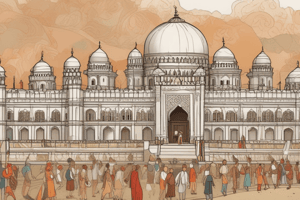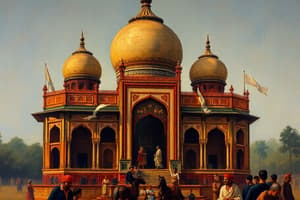Podcast
Questions and Answers
Who established the Mughal Empire in India after his victory in the First Battle of Panipat in 1526?
Who established the Mughal Empire in India after his victory in the First Battle of Panipat in 1526?
Babur
Which Mughal emperor is remembered for his architectural projects including the construction of the Taj Mahal?
Which Mughal emperor is remembered for his architectural projects including the construction of the Taj Mahal?
Shah Jahan
Who was the last Mughal emperor who could assert some level of authority?
Who was the last Mughal emperor who could assert some level of authority?
- Akbar
- Bahadur Shah II
- Bahadur Shah I (correct)
- Shah Jahan
The British East India Company emerged with a monopoly in the subcontinent in 1600.
The British East India Company emerged with a monopoly in the subcontinent in 1600.
The Aligarh Movement, led by Sir Syed Ahmad Khan, aimed to promote modern education among ________.
The Aligarh Movement, led by Sir Syed Ahmad Khan, aimed to promote modern education among ________.
Flashcards are hidden until you start studying
Study Notes
The Mughal Empire
- Covered an area of 4.4 million square kilometers, which is 10% of the Asian continent or 3.3% of the world's land surface area.
- Included present-day India, Nepal, Bangladesh, Pakistan, Bhutan, Sri Lanka, and the Maldives.
Mughal Emperors
- Babur (1526-1530): Established the Mughal Empire in India, known for military prowess, administrative reforms, and his memoir "Baburnama".
- Humayun (1530-1540, 1555-1556): Faced challenges to his rule, marked by attempts at centralized administration and cultural patronage.
- Akbar the Great (1556-1605): Considered one of the greatest Mughal emperors, known for religious tolerance, administrative reforms, military conquests, and the promotion of arts and culture.
- Jahangir (1605-1627): Continued his father's policies, known for his love of art, poetry, and literature, marked by stability and prosperity.
- Shah Jahan (1628-1658): Known for his grand architectural projects, including the construction of the Taj Mahal, marked by wealth and cultural achievements.
- Aurangzeb (1658-1707): Expanded the Mughal Empire to its greatest territorial extent, but marked by religious intolerance and conflicts with regional powers.
Decline of the Mughal Empire
- After Aurangzeb's death in 1707, the Mughal Empire began to decline rapidly due to internal strife, invasions by regional powers, and a weakening of central authority.
- Bahadur Shah I (1707-1712): Last significant Mughal emperor who could assert some level of authority.
- Bahadur Shah II (1837-1857): Last Mughal emperor, his reign was more symbolic, as the British East India Company had de facto control over much of India.
Socio-Political Conditions
- Centralized system of governance with a strong autocratic rule by the Mughal emperors.
- Ethnically and culturally diverse empire with various regions having distinct identities and traditions.
- Mughal administration was a mix of Persian and Indian elements, and society was organized based on the principles of the caste system.
Economic Dynamics
- Agrarian-based economy, with agriculture being the primary source of revenue.
- Flourishing trade and commerce, especially with Europe, Central Asia, and Southeast Asia.
- Well-developed system of taxation, and revenue collected from the provinces was a significant source of income for the empire.
Cultural Environment
- Mughal era was known for its rich cultural and artistic contributions, especially in the fields of art, architecture, literature, and music.
- Persian was the official language of the Mughal court, and the empire saw the patronage of artists, poets, and scholars.
British East India Company
- Established in 1600 with a chartered monopoly of 15 years.
- Entered the subcontinent in 1608.
- Emperor Jahangir allowed the function of EIC in 1615.
- 23 factories in the region by 1647.
- Farrukhsiyar Mughal King exempted all the taxes of EIC in 1717.
The Battle of Plassey
- The victory provided the British East India Company with a strong foothold for further expansion across the subcontinent.
- Political manipulation and diplomacy by the British, gaining the support of Mir Jafar, a key nobleman in the Nawab's court.
- British imposed heavy taxes and tariffs on trade, benefiting from Bengal's prosperous trade and agriculture.
The Rise of British Power
- British continuously encroached upon Indian territories, leading to discontent among local rulers.
- Mir Jafar eventually ran into disputes with the East India Company and attempted to form an alliance with the Dutch East India Company.
- The British eventually defeated the Dutch and overthrew Mir Jafar, replacing him with Mir Qasim.
The Treaty of Allahabad
- Granting the Company the authority to collect revenue and administer the newly acquired territories of Bengal, Bihar, and Orissa.
The Aligarh Movement
- Led by Sir Syed Ahmad Khan in the late 19th and early 20th centuries.
- Aimed to promote modern education among Muslims and bridge the gap between the British rulers and the Muslim community.
- Sought to empower Muslims through education and emphasized loyalty to the British government while preserving Muslim identity.
The Khilafat Movement
- A pan-Islamic movement in response to the dismantling of the Ottoman Caliphate by the Allied Powers after World War I.
- Sought to protect the caliphate and garnered widespread support from Muslims across India, including cooperation from the Indian National Congress.
- The movement was an early example of Hindu-Muslim unity in the political arena.
- The movement gradually lost momentum as the British government and the Allied Powers refused to reverse their decisions regarding the Ottoman Caliphate.
Studying That Suits You
Use AI to generate personalized quizzes and flashcards to suit your learning preferences.




